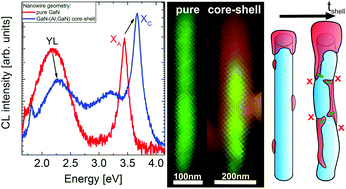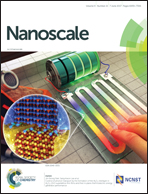Surface passivation and self-regulated shell growth in selective area-grown GaN–(Al,Ga)N core–shell nanowires†
Abstract
The large surface-to-volume ratio of GaN nanowires implicates sensitivity of the optical and electrical properties of the nanowires to their surroundings. The implementation of an (Al,Ga)N shell with a larger band gap around the GaN nanowire core is a promising geometry to seal the GaN surface. We investigate the luminescence and structural properties of selective area-grown GaN–(Al,Ga)N core–shell nanowires grown on Si and diamond substrates. While the (Al,Ga)N shell allows a suppression of yellow defect luminescence from the GaN core, an overall intensity loss due to Si-related defects at the GaN/(Al,Ga)N interface has been observed in the case of Si substrates. Scanning transmission electron microscopy measurements indicate a superior crystal quality of the (Al,Ga)N shell along the nanowire side facets compared to the (Al,Ga)N cap at the top facet. A nucleation study of the (Al,Ga)N shell reveals a pronounced bowing of the nanowires along the c-direction after a short deposition time which disappears for longer growth times. This is assigned to an initially inhomogeneous shell nucleation. A detailed study of the proceeding shell growth allows the formulation of a strain-driven self-regulating (Al,Ga)N shell nucleation model.



 Please wait while we load your content...
Please wait while we load your content...